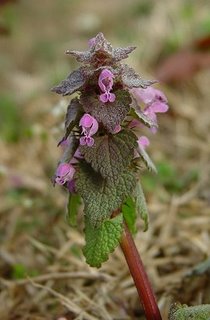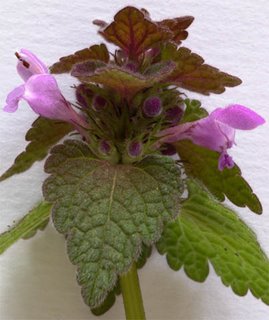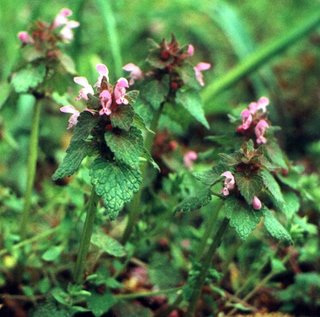Lamium purpureum (nettle, purple, dead)


Purple Archangel.
The Purple Dead-Nettle is a common weed in cultivated ground and by waysides, found in the same spots as the other species, but less conspicuous.
It has heart- or kidney-shaped leaves, blunt, not pointed as in the preceding species, and is distinguished by the purple tinge of its foliage, crowded upper leaves and small, reddish flowers, which have much shorter petal tubes than the Yellow and White DeadNettles, so that bees with shorter tongues than the humble-bee, can reach its honey and fertilize it. It is, indeed, a favourite with bees, who find abundance of honey in its blossoms. The upper leaves are often densely clapped with silky hairs.
It flowers all the summer - from April to September and in mild seasons, both earlier and later. This species of Dead-Nettle is an annual, propagated by its seeds alone. It is one of the earliest weeds in gardens, but being an annual is easily eradicated.
The plant varies greatly in appearance, according to the situation in which it grows. On the open ground, it is somewhat spreading in habit, rarely more than 6 inches in height, whilst specimens growing in the midst of crowded vegetation are often drawn up to a considerable height, their leaves being of a dull green throughout, whereas those of the smaller specimens grown in the open are ordinarily more or less warm and rich in colour. At first glance the variation in the appearance of specimens grown under these different circumstances would leave the casual observer to suppose them to belong to different species.
Medicinal Action and Uses
The herb and flowers, either fresh or dried, have been used to make a decoction for checking any kind of haemorrhage.
The leaves are also useful to staunch wounds, when bruised and outwardly applied.
The dried herb, made into a tea and sweetened with honey, promotes perspiration and acts on the kidneys, being useful in cases of chill.
Linnaeus reported that this species also has been boiled and eaten as a pot-herb by the peasantry in Sweden.




0 Comments:
Post a Comment
<< Home